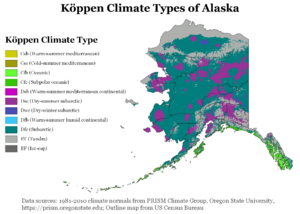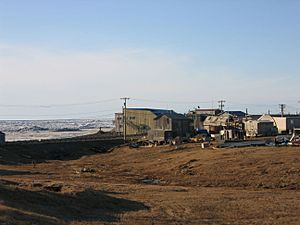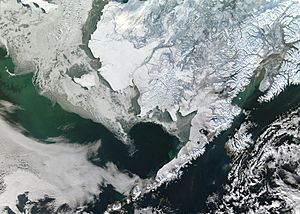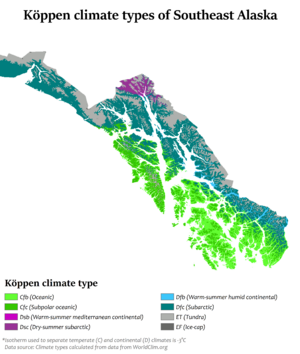Climate of Alaska facts for kids
The climate of Alaska is all about its average temperatures and how much rain or snow it gets each year. Alaska is a huge state, so its weather can be very different from one area to another!
A big reason for Alaska's weather is a path where storms travel, called the extratropical storm track. This path goes along the Aleutian Islands, across the Alaska Peninsula, and along the coast of the Gulf of Alaska. This means these areas get a lot of storms from the North Pacific.
In places like Juneau and the southeast panhandle, the climate is like a mild oceanic climate, similar to Scotland. This means it's often wet and not too hot or too cold. Farther north in the panhandle, it's a bit colder but still wet.
Southcentral Alaska has a subarctic climate. This means it has short, cool summers. The middle of Alaska, called the Alaska Interior, has a very extreme subarctic climate. It gets both the hottest and coldest temperatures ever recorded in Alaska!
The far north of Alaska has an Arctic climate. Here, winters are very long and cold, and summers are cool. It can even snow any time of the year!
Contents
Temperatures Across Alaska
Alaska has many different climates, from mild and rainy to extremely cold and dry. Let's explore how temperatures change across the state.
Southeast Alaska
The climate in Juneau and the Southeast panhandle is quite mild and wet. It's like a temperate rainforest in many southern parts. This area is the wettest and warmest part of Alaska each year. Winters are milder here, and it rains or snows a lot all year round. The most rain usually falls in autumn, especially October, and the least in May or June. This is also one of the few places in Alaska where the average daytime temperature stays above freezing in winter.
Southcentral Alaska
In southcentral Alaska, where Anchorage is located, the climate is milder compared to other parts of the state. This is because it's close to the ocean. While it doesn't get as much rain as the southeast, it gets more snow. However, the days here are often clearer. This region has a subarctic climate, meaning its summers are short and cool. Sometimes, strong winds called Knik wind blow in areas like Palmer, especially in winter.
Western Alaska
The weather in Western Alaska is mostly shaped by the Bering Sea and the Gulf of Alaska. It has a subarctic oceanic climate in the southwest and a continental subarctic climate further north. The temperatures are quite moderate, considering how far north this area is. This region has a huge range of precipitation. For example, the northern part of the Seward Peninsula is actually a desert, getting less than 10 inches (250 mm) of rain or snow a year. But other places, like between Dillingham and Bethel, can get around 100 inches (2,500 mm) of precipitation!
Interior Alaska
The climate in the east, or interior, of Alaska is very extreme. It's a great example of a true continental subarctic climate. Some of Alaska's hottest and coldest temperatures happen near Fairbanks. Summers can reach over 90°F (32°C), while in winter, temperatures can drop below -50°F (-46°C), and sometimes even below -60°F (-51°C)! It doesn't rain or snow much here throughout the year. Most of the precipitation from October to April falls as snow. A thick fog made of ice, called ice fog, can be a big problem during very cold periods from November to March.
Northern Alaska
The climate in the far north of Alaska is exactly what you'd expect for a place north of the Arctic Circle. It's an Arctic climate with very long, very cold winters and short, cool summers. The sun doesn't rise at all for several weeks in winter. In summer, the sun stays out for 24 hours a day! Even with constant sunshine in summer, the average low temperature in Utqiaġvik in July is barely above freezing, at 36°F (2°C). Snow can fall in any month of the year here. Northern Alaska is the coldest part of the state.
Comparing Temperatures
| City | Jan | Feb | Mar | Apr | May | Jun | Jul | Aug | Sep | Oct | Nov | Dec |
|---|---|---|---|---|---|---|---|---|---|---|---|---|
| Anchorage | 23 / 11 (−5 / −12) |
28 / 16 (−2 / −9) |
34 / 18 (1 / −8) |
46 / 30 (8 / −1) |
57 / 40 (14 / 4) |
64 / 48 (18 / 9) |
66 / 53 (19 / 12) |
64 / 51 (18 / 11) |
56 / 43 (13 / 6) |
42 / 31 (6 / −1) |
29 / 18 (−2 / −8) |
25 / 14 (−4 / −10) |
| Utqiaġvik | −4 / −18 (−20 / −28) |
−4 / −18 (−20 / −28) |
−3 / −17 (−19 / −27) |
12 / −2 (−11 / −19) |
28 / 18 (−2 / −8) |
43 / 31 (6 / −1) |
49 / 36 (9 / 2) |
46 / 35 (8 / 2) |
38 / 30 (3 / −1) |
27 / 17 (−3 / −8) |
13 / 0 (−11 / −18) |
1 / −12 (−17 / −24) |
| Fairbanks | 1 / −17 (−17 / −27) |
12 / −11 (−11 / −24) |
25 / −3 (−4 / −19) |
46 / 22 (8 / −6) |
62 / 39 (17 / 4) |
72 / 50 (22 / 10) |
73 / 53 (23 / 12) |
66 / 48 (19 / 9) |
55 / 36 (13 / 2) |
34 / 18 (1 / −8) |
12 / −4 (−11 / −20) |
4 / −13 (−16 / −25) |
| Fort Yukon |
−8 / −22 |
2 / −18 (−17 / −28) |
16 / −8 (−9 / −22) |
39 / 17 (4 / −8) |
60 / 38 (16 / 3) |
72 / 51 (22 / 11) |
74 / 53 (23 / 12) |
66 / 46 (19 / 8) |
52 / 34 (11 / 1) |
30 / 17 (−1 / −8) |
3 / −10 (−16 / −23) |
−4 / −18 (−20 / −28) |
| Juneau (downtown) | 34 / 27 (1 / −3) |
37 / 28 (3 / −2) |
40 / 30 (4 / −1) |
49 / 36 (9 / 2) |
57 / 43 (14 / 6) |
62 / 49 (17 / 9) |
64 / 52 (18 / 11) |
63 / 51 (17 / 11) |
57 / 46 (14 / 8) |
49 / 39 (9 / 4) |
40 / 32 (4 / 0) |
36 / 29 (2 / −2) |
| Sitka | 41 / 32 (5 / 0) |
41 / 32 (5 / 0) |
42 / 33 (6 / 1) |
48 / 37 (9 / 3) |
54 / 43 (12 / 6) |
58 / 48 (14 / 9) |
60 / 53 (16 / 12) |
62 / 53 (17 / 12) |
58 / 49 (14 / 9) |
51 / 42 (11 / 6) |
44 / 36 (7 / 2) |
42 / 33 (6 / 1) |
| Craig | 39 / 33 (4 / 1) |
40 / 32 (4 / 0) |
42 / 33 (6 / 1) |
47 / 37 (8 / 3) |
53 / 43 (12 / 6) |
57 / 48 (14 / 9) |
59 / 52 (15 / 11) |
61 / 53 (16 / 12) |
57 / 48 (14 / 9) |
50 / 42 (10 / 6) |
43 / 36 (6 / 2) |
40 / 34 (4 / 1) |
| Kodiak | 36 / 26 (2 / −3) |
38 / 27 (3 / −3) |
39 / 28 (4 / −2) |
45 / 34 (7 / 1) |
52 / 40 (11 / 4) |
57 / 46 (14 / 8) |
62 / 50 (17 / 10) |
63 / 50 (17 / 10) |
57 / 44 (14 / 7) |
48 / 36 (9 / 2) |
40 / 30 (4 / −1) |
37 / 27 (3 / −3) |
| Kotzebue |
6 / −7 |
10 / −5 (−12 / −21) |
10 / −5 (−12 / −21) |
25 / 10 (−4 / −12) |
40 / 29 (4 / −2) |
55 / 43 (13 / 6) |
61 / 52 (16 / 11) |
58 / 49 (14 / 9) |
49 / 40 (9 / 4) |
32 / 24 (0 / −4) |
17 / 7 (−8 / −14) |
10 / −3 (−12 / −19) |
| Nome | 13 / −2 (−11 / −19) |
17 / 1 (−8 / −17) |
18 / 2 (−8 / −17) |
29 / 16 (−2 / −9) |
44 / 31 (7 / −1) |
55 / 42 (13 / 6) |
58 / 46 (14 / 8) |
56 / 44 (13 / 7) |
49 / 37 (9 / 3) |
36 / 25 (2 / −4) |
24 / 12 (−4 / −11) |
16 / 2 (−9 / −17) |
| Unalaska | 37 / 29 (3 / −2) |
38 / 30 (3 / −1) |
39 / 30 (4 / −1) |
41 / 33 (5 / 1) |
46 / 38 (8 / 3) |
52 / 43 (11 / 6) |
57 / 47 (14 / 8) |
59 / 49 (15 / 9) |
54 / 45 (12 / 7) |
48 / 39 (9 / 4) |
43 / 34 (6 / 1) |
39 / 31 (4 / −1) |
| St. Paul | 29 / 21 (−2 / −6) |
29 / 21 (−2 / −6) |
29 / 20 (−2 / −7) |
34 / 26 (1 / −3) |
40 / 32 (4 / 0) |
47 / 38 (8 / 3) |
51 / 44 (11 / 7) |
53 / 46 (12 / 8) |
50 / 41 (10 / 5) |
43 / 35 (6 / 2) |
37 / 30 (3 / −1) |
33 / 24 (1 / −4) |
Record Temperatures
Alaska has seen some truly extreme temperatures! The highest temperature ever recorded in Alaska was 100°F (38°C). This happened in Fort Yukon on June 27, 1915.
The lowest temperature ever recorded in Alaska was a freezing -80°F (-62°C). This was in Prospect Creek on January 23, 1971. That's only 1°F warmer than the coldest temperature ever recorded in mainland North America! Alaska also holds the record for the lowest temperatures in the U.S. for almost every month of the year.
Precipitation in Alaska
Precipitation means any form of water that falls from the sky, like rain or snow. Alaska gets a lot of it, but it varies greatly by region.
Juneau gets over 50 inches (1,300 mm) of precipitation each year. Some other areas in southeast Alaska can get as much as 275 inches (7,000 mm)! The most rain or snow usually falls in September or October, and the least in May and June.
Because of something called a rain shadow (where mountains block rain from reaching certain areas), southcentral Alaska doesn't get as much rain as the southeast. However, it gets a lot more snow! Places like Valdez can get up to 300 inches (7.6 m) of snow, and even more in the mountains. On average, Anchorage gets about 16 inches (410 mm) of precipitation a year, with about 75 inches (1.9 m) of snow. The northern coast of the Gulf of Alaska can get up to 150 inches (3,800 mm) of precipitation annually.
In western Alaska, the northern part of the Seward Peninsula is very dry, like a desert, with less than 10 inches (250 mm) of precipitation each year. But other spots between Dillingham and Bethel average around 100 inches (2,500 mm) of precipitation.
Inland, away from the coasts, it often rains or snows less than 10 inches (250 mm) a year. On the North Slope, it's even drier, with as little as 4 inches (100 mm) of rain equivalent and about 30 inches (0.76 m) of snow. However, any snow that falls in winter usually stays on the ground all season.
Thunderstorms are pretty rare in most of Alaska. But they do happen in the interior during summer and can sometimes cause wildfires. Anchorage might get a thunderstorm every few years. There has even been a rare thunderstorm in Utqiaġvik on the Arctic coast! While very weak tornadoes and waterspouts are extremely rare, they do sometimes occur. Still, Alaska is considered the state least likely to have tornadoes in the United States.
Weather patterns like La Niña usually bring drier and cooler conditions to Alaska. On the other hand, El Niño events lead to warmer temperatures, but they don't necessarily mean it will be drier or wetter. When the Pacific decadal oscillation is in a certain phase (positive), precipitation can increase by 10–40%.






